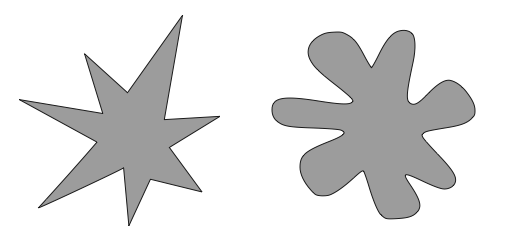Name That Shape

If you are a native English speaker — or, oddly, a native speaker of Tamil (spoken primarily in India) — chances are you called the sharp-pointed image “kiki” and the rounded one “bouba.” And if you did, you’re soundly in the majority. In 2001, per Wikipedia, a pair of researchers surveyed a group of American undergraduates as well as a group of Tamil speakers in India, asking them to label the images using the two words provided. The results: Over 90% of the respondents (in either group!) labeled the left image “kiki” and the right one “bouba.”
The names themselves? They are made-up nonsense — selected because the shapes of the letters used in each word roughly correspond with the blots above. “Kiki” uses letters consisting of straight, sharp lines, while “bouba” has five rounded letters. This suggests that the association described above is entirely based on the shape of the letters, and not the sound of the “words.” But a second study suggests that the letters’ shapes have little to do with it. In 2001, researchers asked two and a half year old children — who could not yet read and in some cases not distinguish between letters — to also label the shapes as either “kiki” or “bouba,” with similar results.
The strong implication from these studies is that cognitively, we associate sounds with shapes on a subconscious, subtextual level.
Bonus fact: The word “bed” looks like a bed.
From the Archives: Cooked to Perfection: Shapes, patented. And then smothered with liquefied cheese.
Related: “The Tell-Tale Brain: A Neuroscientist’s Quest for What Makes Us Human,” by V. S. Ramachandran, one of the researchers who performed the original Bouba/Kiki study.

Leave a comment